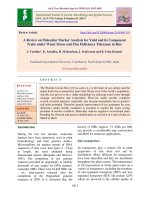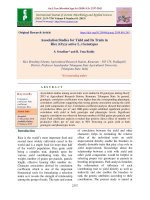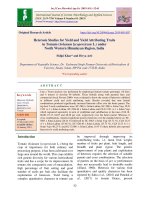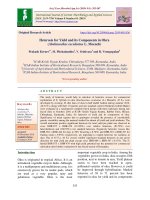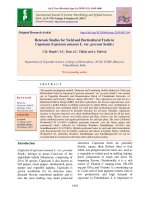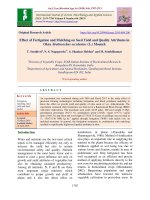Triple test cross analysis for yield and horticultural traits in Brinjal (Solanum melongena L.)
Bạn đang xem bản rút gọn của tài liệu. Xem và tải ngay bản đầy đủ của tài liệu tại đây (161.32 KB, 6 trang )
Int.J.Curr.Microbiol.App.Sci (2017) 6(6): 2807-2812
International Journal of Current Microbiology and Applied Sciences
ISSN: 2319-7706 Volume 6 Number 6 (2017) pp. 2807-2812
Journal homepage:
Original Research Article
/>
Triple Test Cross Analysis for Yield and Horticultural
Traits in Brinjal (Solanum melongena L.)
Smita Kumari*, K.S. Chandel and Aanchal Chauhan
Department of Vegetable Science and Floriculture, CSKHPKV, Palampur (H.P.), India
*Corresponding author
ABSTRACT
Keywords
Brinjal,
Triple test cross,
Epistasis,
Additive and
Dominance
component.
Article Info
Accepted:
26 May 2017
Available Online:
10 June 2017
Vegetable breeding generally depends on the nature and genetic components of variation.
Thus it is necessary to have reliable estimates of such components in order to formulate an
efficient breeding strategy. In the present study, ten diverse inbred lines were crossed to
three testers viz., SP, H-8 and their F1 SP x H-8 at the Experimental Farm, Department of
Vegetable Science and Floriculture, CSKHPKV, Palampur (H.P.) during kharif, 2015 to
assess the nature and magnitude of genetic variability and to understand the association
between different horticultural traits. Data were recorded for marketable fruit yield per
plant, days to 50 per cent flowering, days to first picking, number of marketable fruits per
plant, fruit length and fruit diameter. The parents (lines and testers) and their crosses were
evaluated in Randomized Block Design. Analysis of variance revealed significant
differences among progenies. All the characters showed significant in total epistasis. Both
additive and non-additive interaction i.e., (i) type epistasis was significant for all traits
except fruit length and fruit diameter whereas for (j+l) type epistasis was significant for all
traits except days to first picking. Degree of dominance was in the range of partial
dominance. Correlation coefficient was non-significant for all traits except marketable fruit
yield per plant and days to 50% flowering. Heritability (narrow sense) estimates were low
to medium.
Introduction
Brinjal (Solanum melongena L.) is known as
eggplant or aubergine (French word) belongs
to family Solanaceae and it is also known as
queen of vegetable. It is an autogamous crop
adapted to wide climatic range and exhibit
variation in colour, size and shape of the fruit
(Hazra et al., 2011) and one of the most
commonly grown vegetables all the year
round in the country. India is considered to be
the centre of origin of brinjal (Zeven and
Zhukovsky 1975) with secondary diversity in
China and South East Asia (Nath et al., 1987).
It contains enormous genetic variability which
coupled with its biological diversity make it
suitable for study of genetic principles which
are of practical significance to plant breeders.
The elucidation of genetic components of
variance is an important pre-requisite for
efficient management of available genetic
variability and formulation of systematic
breeding
programme.
However,
the
estimation of these components gets
significantly biased in presence of epistasis,
which leads to erroneous estimation of
2807
Int.J.Curr.Microbiol.App.Sci (2017) 6(6): 2807-2812
genetic parameters. TTC (Triple test cross)
analysis provides unambiguous test for the
presence of epistasis regardless of gene
frequencies, degree of inbreeding and linkage
relationships. The design has wide
applicability as it can be used to investigate
both segregating and non-segregating
populations arising from different generations
such as F2, backcross and homozygous lines.
Therefore the present study was undertaken to
get an insight into the genetic factors
underlying expression of quantitative traits.
Materials and Methods
The material for present study was developed
by crossing ten diverse inbred to three testers
viz., SP, H-8 and their F1 SP x H-8 as per
procedure of Kearsey and Jinks (1968). Thus
the experimental material comprised of 43
genotypes including 10 lines, 3 testers and 30
test cross progenies. Each genotype was
grown in three rows 3.0 m long.
The beds with inter and intra row spacing of
60 cm and 45 cm, respectively and were sown
on raised nursery beds on April 19, 2015 and
transplanting was carried out on June 4, 2015
at the Experimental Farm, Department of
Vegetable
Science
and
Floriculture,
CSKHPKV, Palampur (H.P.) during kharif,
2015. Data were recorded from 10 randomly
selected competitive plants on ten traits viz,
marketable fruit yield per plant, days to 50 per
cent flowering, days to first picking, number
of marketable fruits per plant, fruit length and
fruit diameter. The detection of epistasis was
done as per method of Ketata et al., (1976)
which is based on procedure of Kearsey and
Jinks (1968) and is based on the genetic
model:
Lijk = m + Gij + R k + Eijk
Where,
Lijk = Phenotypic value of cross between test
Li and line j in Kth replication
m = Overall mean of all single and three way
crosses.
Gij = Genotypic value of cross between tester
Li and line j.
Rk = Effect of Kth replication.
Eijk = error.
The mean squares for deviations L1i + L2i – 2
L3i was used for detection of epistasis. The
procedure of Kearsey and Jinks (1968) even
though suffers from the limitation that it only
detects epistasis between loci for which the
testers L1 and L2 differ and there can be
discrepancies due to inadequacies of testers.
However,
the
procedure
provides
unambiguous test of epistasis regardless of
gene frequencies, degree of inbreeding or
linkage relationships.
Results and Discussion
The mean square from the analysis of
variance for 6 characters in triple test cross
families are presented in (Table 1). The mean
squares due to parents (both lines and testers),
crosses and parents v/s crosses indicating
thereby that the inbred lines used in present
study were diverse and that significant
differences were present in progenies for all
traits. This indicated that considerable amount
of genetic variability was present in the
material studied and material was suitable for
the study of manifestation of genetic
parameters involved in the inheritance of
different traits.
The mean square from the analysis of
variance of triple test cross progeny families
for the test of epistasis and the adequacy of
testers for 6 quantitative traits are presented in
Table 2. For detection of epistasis revealed
2808
Int.J.Curr.Microbiol.App.Sci (2017) 6(6): 2807-2812
significant overall epistasis (L1i + L2i – 2L3i)
for all traits. Both additive and non-additive
interaction i.e., (i) type epistasis was
significant for all traits except fruit length and
fruit diameter whereas for (j+l) type epistasis
was significant for all traits except days to
first picking. Epistasis for yield and its
components traits has been also reported by
several recent studies conducted by Kaur and
Thakur (2007), Sabolu et al., (2014), Chauhan
and Chandel (2016) in brinjal.
The estimation of genetic components of
variance was based on analysis of sums and
differences (Table 3). Additive and
dominance component was significant for all
the traits. The degree of dominance was in the
range of partial dominance for all days to 50
% flowering and days to first picking whereas
rest of the characters showed over dominance.
The similar results was finding with
Dhameliya, and Dobariya (2007), Naik et al.,
(2009), Reddy and Patel (2014).
The directional element ‘F’ was positive but
non-significant indicating ambidirectional
nature of dominance for fruit length and fruit
diameter suggesting that alleles with
increasing and decreasing effects appeared to
be dominant and recessive to the same extent
(Table 3). A negative ‘F’ means dominant
alleles carry negative (decreasing) effects
more frequently than positive (increasing)
effects and vice-versa.
Thus, in the present case negative but
significant ‘F’ was observed for marketable
fruit yield per plant (g) and days to 50 per
cent flowering, which means dominant alleles
carry negative (decreasing) effects more
frequently than positive (increasing) effects. It
may be argued that either epistasis or
dominance does not have much of directional
element. Singh and Singh (2010) showed that
the positive and non-significant value of F for
plant height, number of branches per plant,
number of flower per cluster, number of fruit
per plant, fruit size, fruit weight and yield per
plant suggested ambidirectional nature of
dominance in tomato.
Narrow sense heritability is important for
breeding programmes as it estimates the
relative importance of the additive portion of
the genetic variance that can be transmitted to
the next generation.
According to Bhateria et al., (2006) the
narrow sense heritability (h2ns) estimates
were classified as high (> 50 %), medium (3050 %) and low (< 30 %). On the basis of
present study, heritability estimates were low
to moderate with highest value recorded for
bacterial wilt incidence (43.45 %) and lowest
value for marketable fruit yield per plant (g)
(-0.43 %). Low narrow sense heritability
estimates that genetic variation of these traits
is mainly affected by the non-additive gene
effects. This indicates that selection in early
hybrid generations may be successful. These
are findings with Salehuzzaman (1983),
Chaudhary (2001) and Dagade (2015).
Genetic architecture of any crop species has a
great bearing on success of breeding
procedures. Since it is already established that
estimates of genetic parameters get biased in
presence of epistasis, it is imperative to get a
clearer picture by getting unbiased estimates
of such parameters. In this context, triple test
cross is a useful procedure to detect epistatic
bias and is equally applicable to segregating
and non-segregating generations such as F2,
backcross and homozygous lines (Kearsey
and Jink, 1968 and Chahal and Jinks, 1978).
2809
Int.J.Curr.Microbiol.App.Sci (2017) 6(6): 2807-2812
Table.1 Analysis of variance for yield and its component traits in triple test cross
Progenies of brinjal – mean squares
Source of variation
Replic
ation
2
24.123
Parent
Traits df
12
Marketable fruit yield
74975.2**
per plant (g)
Days to 50 % flowering
7.837
110.62**
Days to first picking
23.171
134.31**
Number of marketable
40.123
16.41**
fruits per plant
Fruit length (cm)
30.195
9.28**
Fruit diameter (cm)
0.333
1.55**
*, ** Significant @ 5 % and 1% level
Line
Tester
Crosses
Error
29
45298.05**
Parent vs
Crosses
1
8804.88**
9
42142.77**
2
14789.70**
120.03**
137.31**
17.007 **
110.77**
175.00**
15.18**
98.76**
110.75**
19.73**
12.46**
12.56*
89.02**
3.20
2.88
4.97
6.82 *
1.26**
16.45 **
0.66**
12.76**
1.932**
45.92**
5.56**
2.96
0.34
84
54.23
Table.2 Analysis of variance for detection of epistasis for yield and its component
Traits in brinjal – mean squares
Source of variation
Epistasis
(L1i + L2i 2L3i)
10
Traits
df
97191.52**
Marketable fruit yield
per plant (g)
191.23**
Days to 50 %
flowering
297.36**
Days to first picking
152.73**
Number of marketable
fruits per plant
54.61**
Fruit length (cm)
14.86**
Fruit diameter (cm)
*, ** Significant @ 5 % and 1% level
i-type
interaction
(j+l) type
interaction
Epistasis ×
Replication
i type ×
Replication
(j+l) type
x
replication
18
1
9
20
21427.84**
163.70**
105609.71*
*
210.84**
85.48
98.31
84.06
16.93
31.60
15.30
136.78**
794.33**
97.36
181.44**
7.30
30.76
2.80
13.48
7.80
32.68
15.46
0.179
52.30**
16.49**
16.23
1.05
13.10
2.37
16.58
0.91
2
Table.3 Estimates of additive and dominance components, degree of dominance, correlation
coefficient (sums and differences) and heritability for yield and its component traits in brinjal
Source of variation
D
Marketable fruit yield per
20421.11**
plant (g)
Days to 50 % flowering
422.21**
Days to first picking
473.79**
Number of marketable fruits
21.02*
per plant
Fruit length (cm)
23.06**
Fruit diameter (cm)
5.03*
*, ** Significant @ 5 % and 1% level
Estimates of genetic parameters
(H/D)1/2
r
F
H
51144.29**
1.58
0.25**
-12722.14**
Heritability
(n.s)
-0.43
151.62**
119.65**
66.05**
0.59
0.50
1.77
0.15**
0.30
0.48
-18.68**
-35.53
-2.67
10.52
12.26
8.16
45.29**
6.32
1.40
1.12
-0.39
-0.30
5.53
0.71
0.18
-1.68
2810
Int.J.Curr.Microbiol.App.Sci (2017) 6(6): 2807-2812
The present study revealed (i) type epistasis
was significant for all traits except fruit length
and fruit diameter and whereas for (j+l) type
epistasis was significant for all traits except
days to first picking. Deshmukh et al., (2014)
suggested that non-additive interactions are
more important for components of yield
rather than plant characteristics. Since (j+l)
type epistasis is more useful for hybrid
development therefore hybrid breeding can be
a viable approach for brinjal improvement.
components of variation by models assuming
absence of epistasis would be significantly
biased and can cause consequent bias in
estimates of heritability and other genetic
parameters. However, as of now, there is no
conclusive evidence about the extent of bias
and the effect of epistasis on the expression of
quantitative traits. Studies for assessment of
relative importance of epistatic component
need to be carried out by developing
appropriate genetic modes.
Additive component was significant for all
the traits whereas dominance component was
significant for all traits except fruit diameter.
The preponderance of additive component for
expression of fruit yield and other traits
indicate the amenability of these traits to
improvement through simple selection
procedure. But one of the important
implications of existence of substantial
amount of epistatic component is that
selection procedure shall not be fruitful in
immediate progenies and process has to be
delayed to later generations when appreciable
homozygosity is
achieved.
Recurrent
selection procedures may be useful in the
sense that it will exploit both additive and
non-additive components of genetic variation
for bringing about improvement in fruit yield
and its related attributes. Such a strategy will
help increase frequency of favourable alleles
while maintaining genetic variation in
breeding population (Doerksen et al., 2003).
In fact reciprocal recurrent selection sets in
favourable changes in the population
performances and is designed to make use of
both additive and non-additive components.
The perusal of Table 3 reveals non-significant
correlation coefficients due to sums and
differences, which depict the direction of
dominance. Thus positive and negative genes
are equally distributed among the parents
used in the present study. Since epistasis was
detected for most of the traits, it is hereby
inferred
that
estimation
of
genetic
For the inheritance of different characters the
triple test cross exhibited that the additive,
dominance and epistasis gene actions were
important. In early segregating generations
biparental mating as well as mating of
selected plants could be attempted for
developing potential populations having
optimum levels of homozygosity and
heterozygosity.
Although,
transgressive
segregants can be isolated by alternative
intermating and subsequent handling of
segregating generations in order to obtain
high yielding stable lines in brinjal where all
the three kinds of gene effects are present.
Acknowledgement
The author is highly grateful to Dr. K.S.
Chandel (Professor) for his help in
development of test cross progenies at
Vegeatble farm, Palampur (H.P.), India.
References
Bhateria, S., Sood, S.P. and Pathania, A.
2006. Genetic analysis of quantitative
traits across environments in linseed
(Linum usitatissimum L.). Euphytica,
150: 185-194.
Chahal, G.S. and Jinks, J.L. 1978. A general
method of detecting the additive,
dominance and epistatic variation that
inbred lives can generate using single
tester. Heredity. 40: 117-125.
2811
Int.J.Curr.Microbiol.App.Sci (2017) 6(6): 2807-2812
Chaudhary, D.R. 1999. Components of
genetic variation in yield traits of brinjal
(Solanum melongenaL.). Himachal
Journal of Agricultural Research, 25
(1/2): 43-47.
Chauhan, A. and Chandel, K.S. 2016. Genetic
analysis of biparental progenies in
eggplant, Solanum melongena L.
International Journal of Farm Sciences,
6(2): 84-96.
Dagade, S.B., Dhaduk, L.K., Mehata, D.R.
and Barad, A.V. 2015. Genetic
architecture of some yield and
biochemical traits of tomato Solanum
lycopersicum L. Electronic Journal of
Plant Breeding. 6 (3): 787-791.
Deshmukh, S.B., Sawant, S.N., Narkhede,
G.W. and Dod, V.N. 2014. Gene Action
Studies
in
Brinjal
(Solanum
melongena). Middle-East Journal of
Scientific Research. 21(11): 2177-2181.
Doerksen, T., Kannenberg, L. and Lee, L.
2003. Effect of recurrent selection on
combining ability in maize breeding
populations. Crop Sci. 43: 1652-1658.
Hazra, P., Chattopadhyay, A., Karmakar, K.
and Dutta, S. 2011. Brinjal In: Modern
Technology in Vegetable Production.
New India Publishing Agency, New
Delhi. pp. 103 – 114.
Kaur, A. and Thakur, J.C. 2007. Genetic
studies in brinjal through biparental
mating. Haryana Journal of horticultural
Science. 36(3and4): 331-333.
Kearsey, M.J. and Jinks, J.L. 1968. A general
method
for
detecting
additive,
dominance and epistatic variation for
metrical traits. Heredity. 23: 403-409.
Ketata, H., Smith, E.L., Edwards, L.H. and
McNew, R.W. 1976. Detection of
epistatic, additive and dominance
variation in winter wheat. Crop Sci. 16:
1-4.
Nath, P., Velayudhan, S. and Singh, D.P.
1987. Vegetable for the Tropical
Region. Indian Council of Agricultural
Research, New Delhi, pp 23-24.
Reddy, E.E.P. and Patel, A.I. 2014. Studies on
gene action and combining ability for
yield and other quantitative traits in
brinjal (Solanum melongena L.). Trends
in Biosciences 7(5): 381-383.
Sabolu, S., Keshubhai, B.K., Chintan, R.M.
and Kumar, S. 2014. Generation mean
analysis of fruit quality traits in
eggplant (Solanum melongena L.).
African Journal of Crop Science 8(2):
243-250.
Salehuzzaman, M. and Alam, M.S. 1983.
Genetic analysis of yield and its
components in the eggplant. SABRAO
Journal. 15(1): 11-15.
Singh, J.P. and Singh, K.P. 2010. Modified
triple test cross analysis for yield and its
component in tomato (Licopersican
esculentum MILL.). Veg. Sci. 37(1):
102-104.
Zeven, A.C. and Zhukovsky, P.M. 1975.
Dictionary of cultivated plants and their
centres of diversity. Wageningen,
Netherlands. 219p.
How to cite this article:
Smita Kumari, K.S. Chandel and Aanchal Chauhan. 2017. Triple Test Cross Analysis for Yield
and Horticultural Traits in Brinjal (Solanum melongena L.). Int.J.Curr.Microbiol.App.Sci. 6(6):
2807-2812. doi: />
2812
